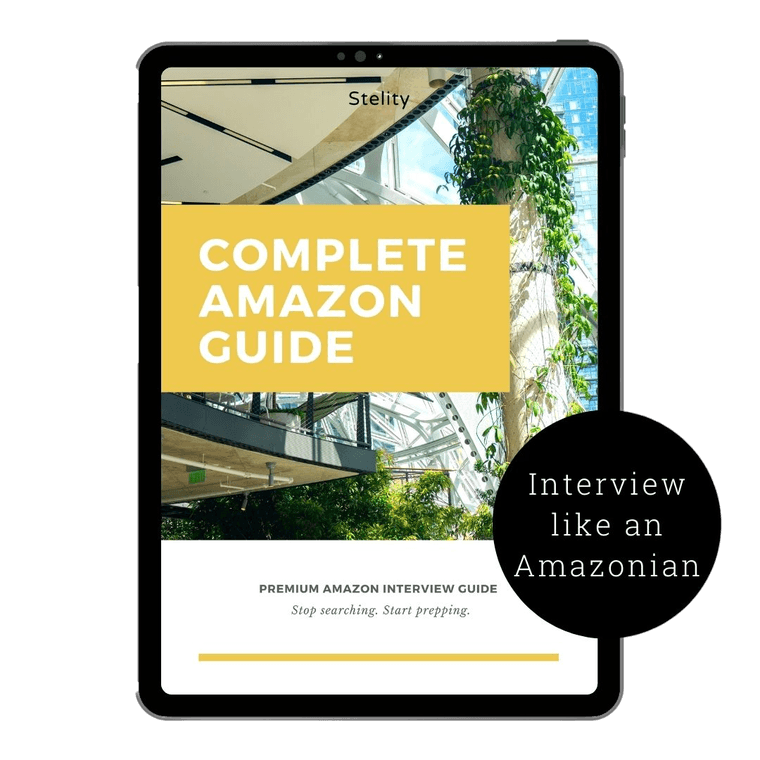5 Step Guide to Behavioural Amazon Interview Questions
Landing a role at Amazon is notoriously challenging. Amazon receives hundreds of applications for every role and has one of the most difficult interview processes out of all the tech companies.
Candidates interviewing for a role at Amazon can expect to encounter primarily behavioural Amazon interview questions built around the Amazon Leadership Principles. To call them questions is misleading. You need to expect mini-discussions with follow up questions diving into nuanced areas. It's really important to prepare appropriately, refresh your memory of experiences and reflect on your decisions. These can be challenging discussions to handle on the fly. 'Winging it' is not the best approach for the Amazon interview.
Amazon's recruitment process is built to eliminate bias and assess cultural fit. Amazon takes the behavioural interview process seriously and so should you. The interviewers will be taking detailed notes which will be discussed in debriefs with other members of the hiring team. While the vast majority of interview time will be spent on Behavioural Amazon Interview Questions. You should also expect the usual ‘Tell me about your background’, ‘Tell me about yourself’, and ‘Why Amazon’ interview questions.
What to expect from Behavioural Amazon Interview Questions
Amazon Behavioural Interview Questions look something like this:
What was your most innovative idea?
Tell me about a time you led a project and it failed?
Tell me about a time you disagreed with your manager?
See more Behavioural Amazon Interview Questions
These questions focus on an example from your professional past and zero in on what you did, why you did it, how you did it and what the impact was. Amazon is looking to understand how you've behaved in challenging situations in the past, to get an idea of how they can expect you to behave in the future.
Use the STAR format
Amazon expects answers to be provided in the STAR format, which is just an acronym that stands for:
S - Situation
T - Task
A - Action
R - Result
This means that when you're asked a behavioural question, such as "What was your most innovative idea," you would:
Situation: Briefly describe the situation, context, and what you needed to do.
Task: Describe the tasks associated with achieving the objective.
Action: Identify the actions you personally took to achieve those tasks.
Result: Share the impact, or results, and any learnings.
The STAR method is designed to provide the critical elements of the interview story. Professional experiences are often complex and this structure provides a clear framework. It also helps keep the story focused so you don't fall into the trap of over-sharing irrelevant information.
The STAR method: Amazon example answer
Question: Tell me about a time when a project you were managing didn’t go as expected.
Situation: There was a time when I was managing the switchover from one technology to another in an AVOD product. There was an error that we weren’t aware of that was causing the product to lag and we didn’t know until customers started flooding our customer support and social feeds with complaints. I was the product manager and I stepped up to be accountable for the challenge and working with the relevant software teams to address it.
Tasks: First we had to debug the code to find the error. There was an issue causing memory problems and we traced the error back to an earlier deployment of an update. We knew it would take too long to fix the root issue so I decided we needed to get a quick fix going to sort the issue asap.
Action: Once we had the quick fix up and running and the complaints stopped flooding in, I kicked off a work stream to fix the root cause. I also updated our release checks and processes to ensure an error like this would be caught in advance next time. We also set up an application management tool so next time something goes wrong and the website isn’t meeting our performance KPIs or SLAs the team would immediately get alerts.
Result: Our customers were happy we were able to get a fix up within 45 minutes and our product load times went back to 4s. I shared this with other Product Owners in case there was something they could learn from the experience and we added a checklist to the release process to prevent these errors in the future. I learned the importance of being aware of how a software deployment is going. I realised this was a blindspot for me and the experience taught me how to keep a full 360 view.
After providing an interview answer in the STAR format, you should expect the interviewer to ask several follow up questions. They will ask you to clarify parts of the answer and prompt you to further discuss areas they would like more information on. It’s important you don’t try to second guess the interviewer and give too much information up front. Make sure you leave space for a discussion.
There are alternate methods to the STAR method, such as the SOARA (Situation-Objective-Action-Result-Aftermath) and PAR (Problem-Action-Result). These STAR method alternatives either combine elements of STAR into one, or add an additional element. Their core is the same, and gives you structure to provide background, the challenge, your actions, and the impact of those actions. Amazon specifically asks for STAR and will be taking notes in that format so we advise you start there.
Amazon Leadership Principles
Amazon's behavioural questions focus on behaviours associated with the 14 Amazon Leadership Principles. Each principle has a list of questions the interviewer may choose from. The role you are applying for will have core Leadership Principles associated with it, and your questions will focus on the LPs most important for that particular role. For example, the Amazon leadership principles applicable to a Marketing Manager with no team will be different from those applicable for a Senior Data Science Manager with a team of 12. You can expect questions from any of the principles, but the core ones for the role you seek will come up a few times in your interview process.
The core 14 Amazon Leadership Principles are:
Customer Obsession
Ownership
Invent & Simplify
Are Right, A lot
Learn and Be Cautious
Hire and Develop the Best
Insist on the Highest Standards
Think Big
Bias for Action
Frugality
Earn Trust
Dive Deep
Have Backbone; Disagree & Commit
Deliver Results
Two more new Leadership Principles were added in 2021:
- Strive to be Earth’s best employer
- Success and Scale Bring Broad Responsibility
Get our FREE Amazon Leadership Principles PDF here.
Your interviewer will take detailed notes and ask follow up questions to drill into the specific areas they're looking to uncover. Your answers to the Behavioural Interview Questions will hold more weight in hiring decisions than any other aspect of the interview.
Common Behavioural Amazon Interview Questions
Tell me about a time you handled a difficult customer
Tell me about a time you weren’t able to meet a time commitment.
Tell me about a time where you had to leave a task unfinished.
What is the most difficult situation you have faced.
Give me an example of a time when you were 75% of the way through a project, and had to pivot strategy?
Tell the story of the last time you had to apologise to someone.
If your direct manager was instructing you to do something you disagreed with, how would you handle it?
What’s the worst mistake you ever made?
What’s the most innovative thing you’ve done?
Tell me about a time you obsessed over giving a high quality service to a customer?
FREE DOWNLOAD: 30 Common Amazon Interview Questions
From the blog: The 3 types of Amazon Interview Questions
5 Steps to a Successful Amazon Interview
1. Carefully research the role you are applying for
Read the job description. Research the team. Research the product. Talk to the recruiter, if you can. Ask questions. The clues to the most important Amazon Leadership Principles for each role are usually in plain sight. Uncovering these will dramatically focus your interview preparation.
Our foolproof guide to planning your Amazon Interview Research includes a handy list of essential sources you don’t want to miss.
2. Understand the Amazon Leadership Principles
This is the most important part of your interview preparation. Read the principles. Think about them. Research examples of the principles in action. You want to get to a point where you know them inside out. Research them yourself or grab our Stelity Essential or Complete guides which have all this distilled.
Download our FREE Amazon Leadership Principles pdf and Watch Jeff Bezos at the 2020 Antitrust Congress hearing to see how he uses the Amazon Leadership Principles in his testimony.
3. Familiarise yourself with common questions
While you can't anticipate what you will be asked, it is beneficial to understand the flavour of common questions. This helps calibrate to what you can expect and give you a range of topics you need to be thinking about. It also helps you understand how Amazon thinks.
4. Identify your best professional experiences
Think about situations from your career that illustrate the Amazon Leadership Principles. Identify your best projects, relevant situations, and interpersonal experiences that showcase how you work through challenges. Try to identify at least 2-3 different experiences for each Amazon Leadership Principle.
Stelity's Complete Amazon Interview Toolkit includes detailed guides and prompts to find your best responses for each of the 16 Amazon Leadership Principles
5. Think about the STAR method components for each experience
You'll want to develop some grounded ideas around the Situation, Action, Task and Result associated with each of the examples you have. Write down some bullet points for each in order to guide your thinking. Review and revise until you can be both thorough and brief.
Shortcut your prep with Stelity Amazon Interview Toolkits
No time? We've invested hours into developing Stelity toolkits, so you don't have to. Inside the Amazon Interview toolkits you’ll find:
Popular reads







